Microstructure Evolution of Reactor Pressure Vessel A508-3 Steel under High-Dose Heavy Ion Irradiation
Abstract
:1. Introduction
2. Materials and Methods
2.1. Materials and Microstructural Characterization
2.2. Ion Irradiation Test
2.3. Transmission Electron Microscopy
3. Results and Discussion
4. Conclusions
Author Contributions
Funding
Institutional Review Board Statement
Informed Consent Statement
Data Availability Statement
Conflicts of Interest
References
- Davies, L.M. A comparison of western and eastern nuclear reactor pressure vessel steels. Int. J. Press. Vessel. Pip. 1999, 76, 163–208. [Google Scholar] [CrossRef]
- Rogner, H.-H. World outlook for nuclear power. Energy Strategy Rev. 2013, 1, 291–295. [Google Scholar] [CrossRef]
- Slugen, V.; Hein, H.; Sojak, S.; Pecko, S.; Veternikova, J.S.; Petriska, M.; Sabelova, V.; Bartosova, I.; Stacho, M. German and Russian Irradiated Reactor Pressure Vessel Steels from PAS Point of View. Acta Phys. Pol. A 2014, 125, 726–728. [Google Scholar] [CrossRef]
- Kuleshova, E.A.; Fedotov, I.V. Annealing as a Technique for Estimating the Structural Elements Contribution to NPP Materials Service Properties. Phys. Met. Metallogr. 2019, 120, 763–769. [Google Scholar] [CrossRef]
- Lu, K.; Katsuyama, J.; Li, Y. Plasticity Correction on Stress Intensity Factor Evaluation for Underclad Cracks in Reactor Pressure Vessels. J. Press. Vessel. Technol. 2020, 142, 051501. [Google Scholar] [CrossRef]
- Kuleshova, E.A.; Gurovich, B.A.; Bukina, Z.V.; Frolov, A.S.; Maltsev, D.A.; Krikun, E.V.; Zhurko, D.A.; Zhuchkov, G.M. Mechanisms of radiation embrittlement of VVER-1000 RPV steel at irradiation temperatures of (50-400) degrees C. J. Nucl. Mater. 2017, 490, 247–259. [Google Scholar] [CrossRef]
- Lin, Y.; Yang, W.; Tong, Z.; Zhang, C.; Ning, G. Charpy impact test on A508-3 steel after neutron irradiation. Eng. Fail. Anal. 2017, 82, 733–740. [Google Scholar] [CrossRef]
- Zhang, T.; Wang, H.; Li, Z.; Schut, H.; Zhang, Z.; He, M.; Sun, Y. Positron Annihilation Investigation of Embrittlement Behavior in Chinese RPV Steels after Fe-Ion Irradiation. Acta Metall. Sin. 2018, 54, 512–518. [Google Scholar]
- Hawthorne, J.R. Irradiation Embrittlement. Treatise Mater. Sci. Technol. 1983, 25, 461–524. [Google Scholar] [CrossRef]
- Gillemot, F. Review on Steel Enhancement for Nuclear RPVs. Metals 2021, 11, 2008. [Google Scholar] [CrossRef]
- Liu, Y.; Nie, J.; Lin, P.; Liu, M. Irradiation tensile property and fracture toughness evaluation study of A508-3 steel based on multi-scale approach. Ann. Nucl. Energy 2020, 138, 107157. [Google Scholar] [CrossRef]
- Belkacemi, L.T.; Meslin, E.; Décamps, B.; Crocombette, J.P.; Tissot, O.; Vandenberghe, T.; Décamps, P.; Sauvage, T.; Berthier, C. Role of displacement cascades in Ni clustering in a ferritic Fe-3.3 at%Ni model alloy: Comparison of heavy and light particle irradiations. Scr. Mater. 2020, 188, 169–173. [Google Scholar] [CrossRef]
- Bergner, F.; Gillemot, F.; Hernandez-Mayoral, M.; Serrano, M.; Török, G.; Ulbricht, A.; Altstadt, E. Contributions of Cu-rich clusters, dislocation loops and nanovoids to the irradiation-induced hardening of Cu-bearing low-Ni reactor pressure vessel steels. J. Nucl. Mater. 2015, 461, 37–44. [Google Scholar] [CrossRef]
- Ziegler, J.F.; Ziegler, M.D.; Biersack, J.P. SRIM—The stopping and range of ions in matter. Nucl. Instrum. Methods Phys. Res. Sect. B Beam Interact. Mater. At. 2010, 268, 1818–1823. [Google Scholar] [CrossRef]
- Zinkle, S.J.; Snead, L.L. Opportunities and limitations for ion beams in radiation effects studies: Bridging critical gaps between charged particle and neutron irradiations. Scr. Mater. 2018, 143, 154–160. [Google Scholar] [CrossRef]
- Ma, X.; She, M.; Zhang, W.; Song, L.; Qiu, S.; Liu, X.; Zhang, R. Microstructure characterization of reactor pressure vessel steel A508-3 irradiated by heavy ion. J. Phys. Conf. Ser. 2021, 2133, 012015. [Google Scholar] [CrossRef]
- Ding, Z.N.; Han, X.X.; Yang, Y.T.; Chen, Y.G.; Zhang, X.L.; Niu, M.K.; Zhang, C.H.; Liu, X.B.; Xue, F. Characterization of microstructures and mechanical property of Fe-ion-irradiated China A508-3 steel. Nucl. Instrum. Methods Phys. Res. Sect. B Beam Interact. Mater. At. 2021, 504, 14–20. [Google Scholar] [CrossRef]
- Balbuena, J.P.; Aliaga, M.J.; Dopico, I.; Hernández-Mayoral, M.; Malerba, L.; Martin-Bragado, I.; Caturla, M.J. Insights from atomistic models on loop nucleation and growth in alpha-Fe thin films under Fe+ 100 keV irradiation. J. Nucl. Mater. 2019, 521, 71–80. [Google Scholar] [CrossRef]
- Schäublin, R.; Décamps, B.; Prokhodtseva, A.; Löffler, J.F. On the origin of primary 1/2 a(0) <111> and a(0) <100> loops in irradiated Fe(Cr) alloys. Acta Mater. 2017, 133, 427–439. [Google Scholar] [CrossRef]
- Yao, Z.; Hernández-Mayoral, M.; Jenkins, M.L.; Kirk, M.A. Heavy-ion irradiations of Fe and Fe-Cr model alloys Part 1: Damage evolution in thin-foils at lower doses. Philos. Mag. 2008, 88, 2851–2880. [Google Scholar] [CrossRef]
- Terentyev, D.A.; Osetsky, Y.N.; Bacon, D.J. Effects of temperature on structure and mobility of the < 1 0 0 > edge dislocation in body-centred cubic iron. Acta Mater. 2010, 58, 2477–2482. [Google Scholar]
- Marian, J.; Wirth, B.D.; Schaublin, R.; Perlado, J.M.; de la Rubia, T.D. (100)-loop characterization in alpha-Fe: Comparison between experiments and modeling. J. Nucl. Mater. 2002, 307, 871–875. [Google Scholar] [CrossRef]
- Xu, H.; Stoller, R.E.; Osetsky, Y.N.; Terentyev, D. Solving the Puzzle of <100> Interstitial Loop Formation in bcc Iron. Phys. Rev. Lett. 2013, 110, 2665503. [Google Scholar] [CrossRef]
- Kapoor, G.; Chekhonin, P.; Kaden, C.; Vogel, K.; Bergner, F. Microstructure-informed prediction and measurement of nanoindentation hardness of an Fe-9Cr alloy irradiated with Fe-ions of 1 and 5 MeV energy. Nucl. Mater. Energy 2022, 30, 101105. [Google Scholar] [CrossRef]
- Huang, Y.; Xue, Z.; Gao, H.; Nix, W.D.; Xia, Z.C. A study of microindentation hardness tests by mechanism-based strain gradient plasticity. J. Mater. Res. 2000, 15, 1786–1796. [Google Scholar] [CrossRef]
- Bakaev, A.; Zhao, J.; Terentyev, D.; Bonny, G.; Castin, N.; Kuronen, A.; Kvashin, N.; Nordlund, K.; Bakaev, V.A.; Golikov, I.G. Effect of radiation defects on the early stages of nanoindentation tests in bcc Fe and Fe-Cr alloys. Comput. Mater. Sci. 2022, 204, 111151. [Google Scholar] [CrossRef]
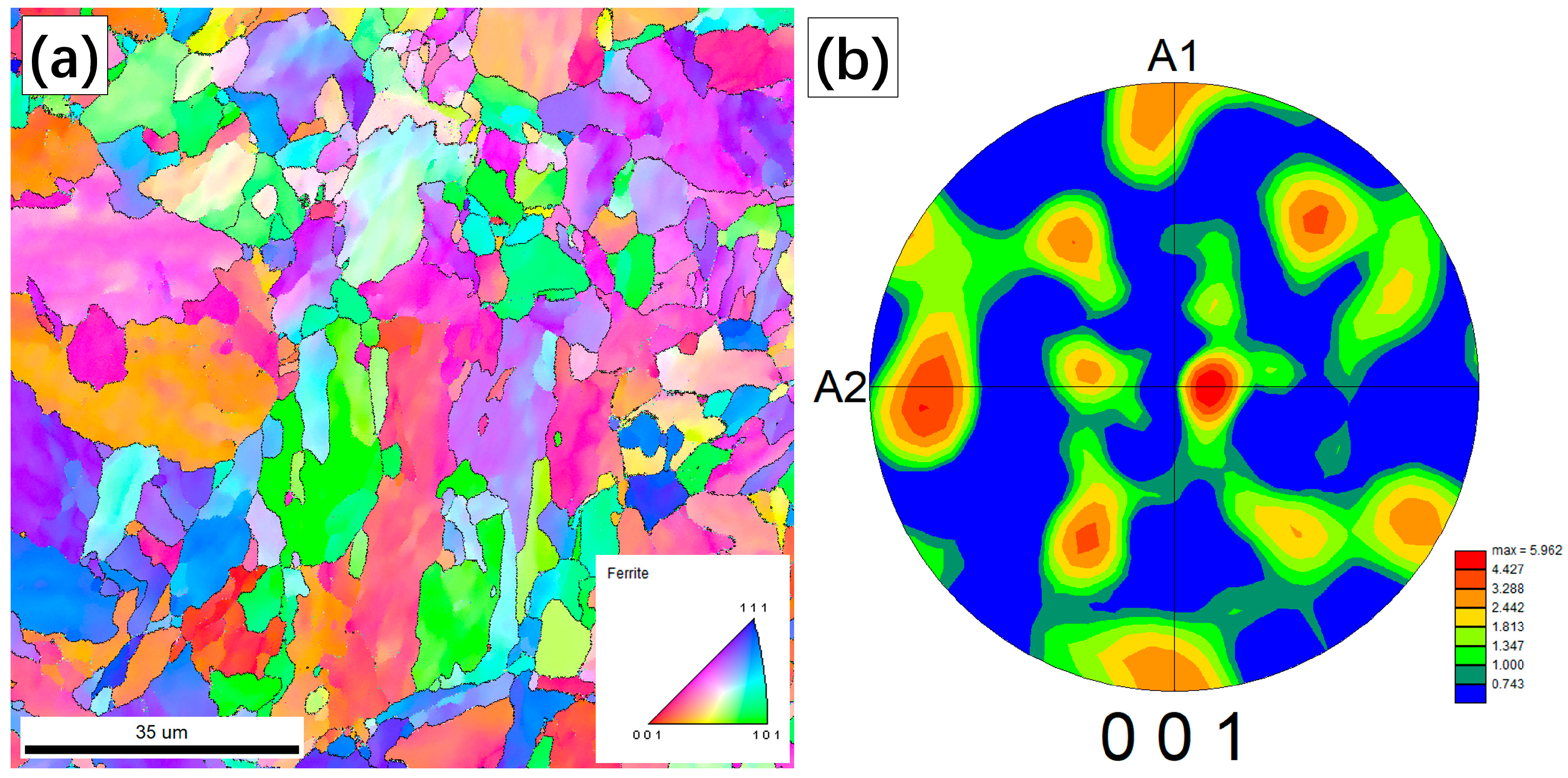
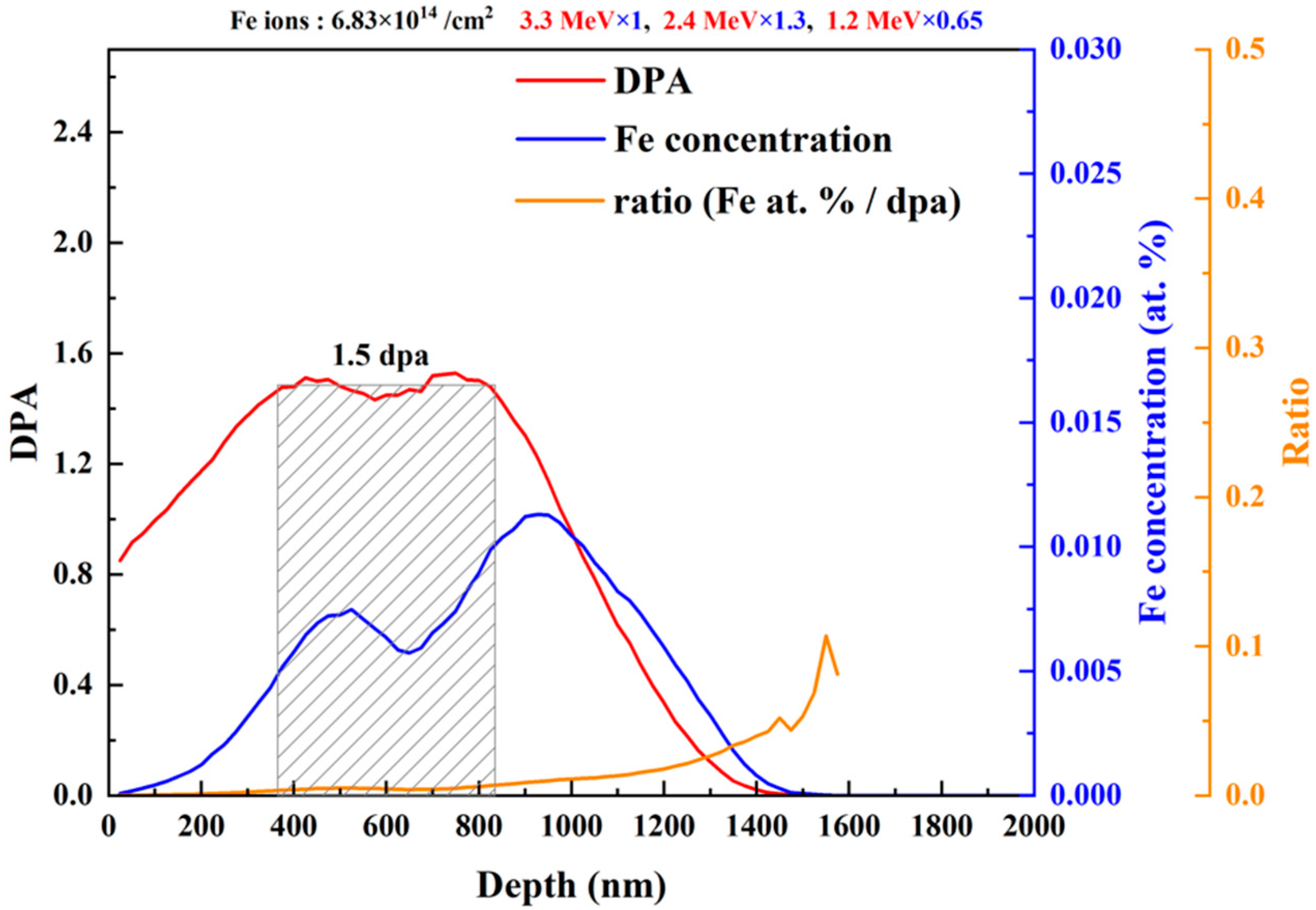
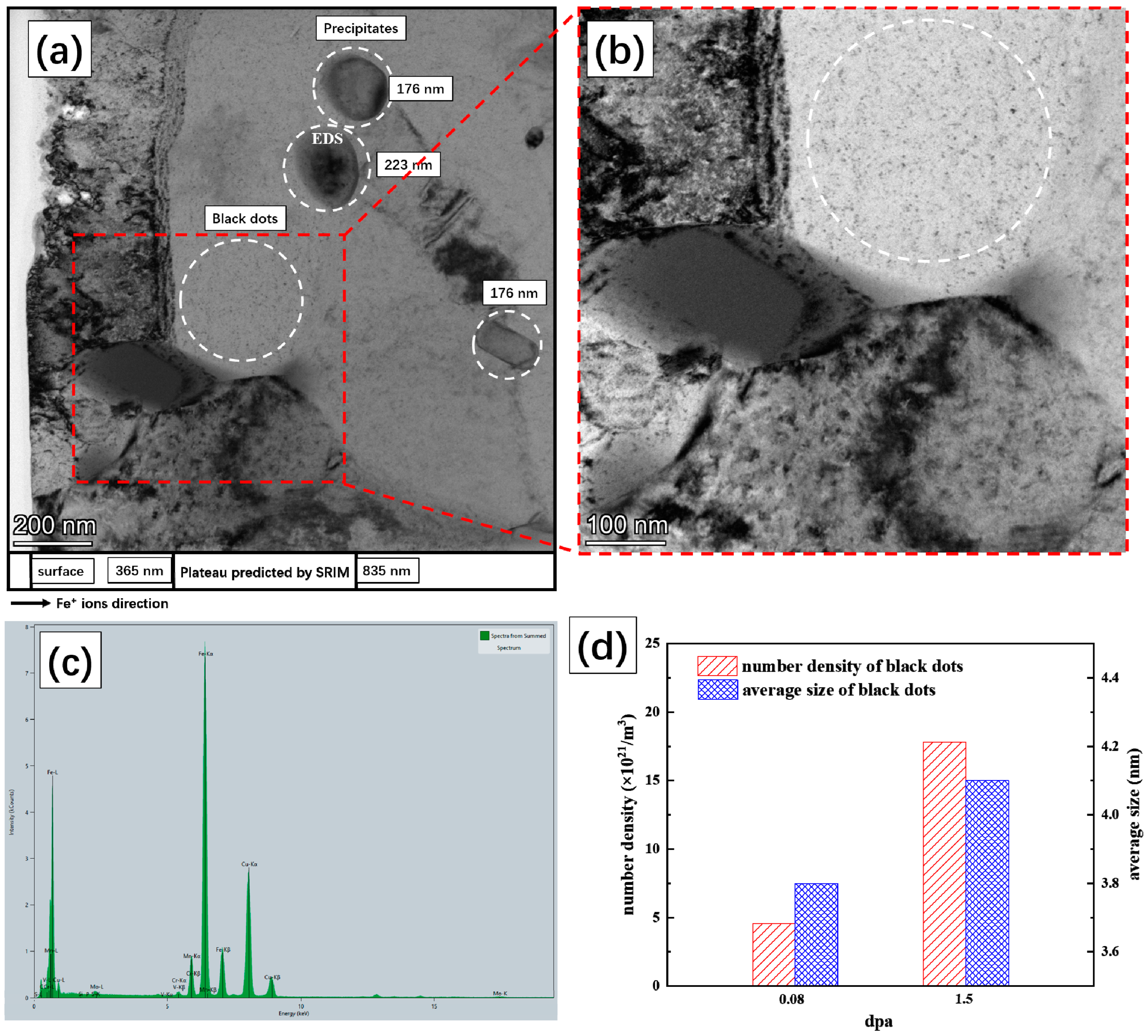

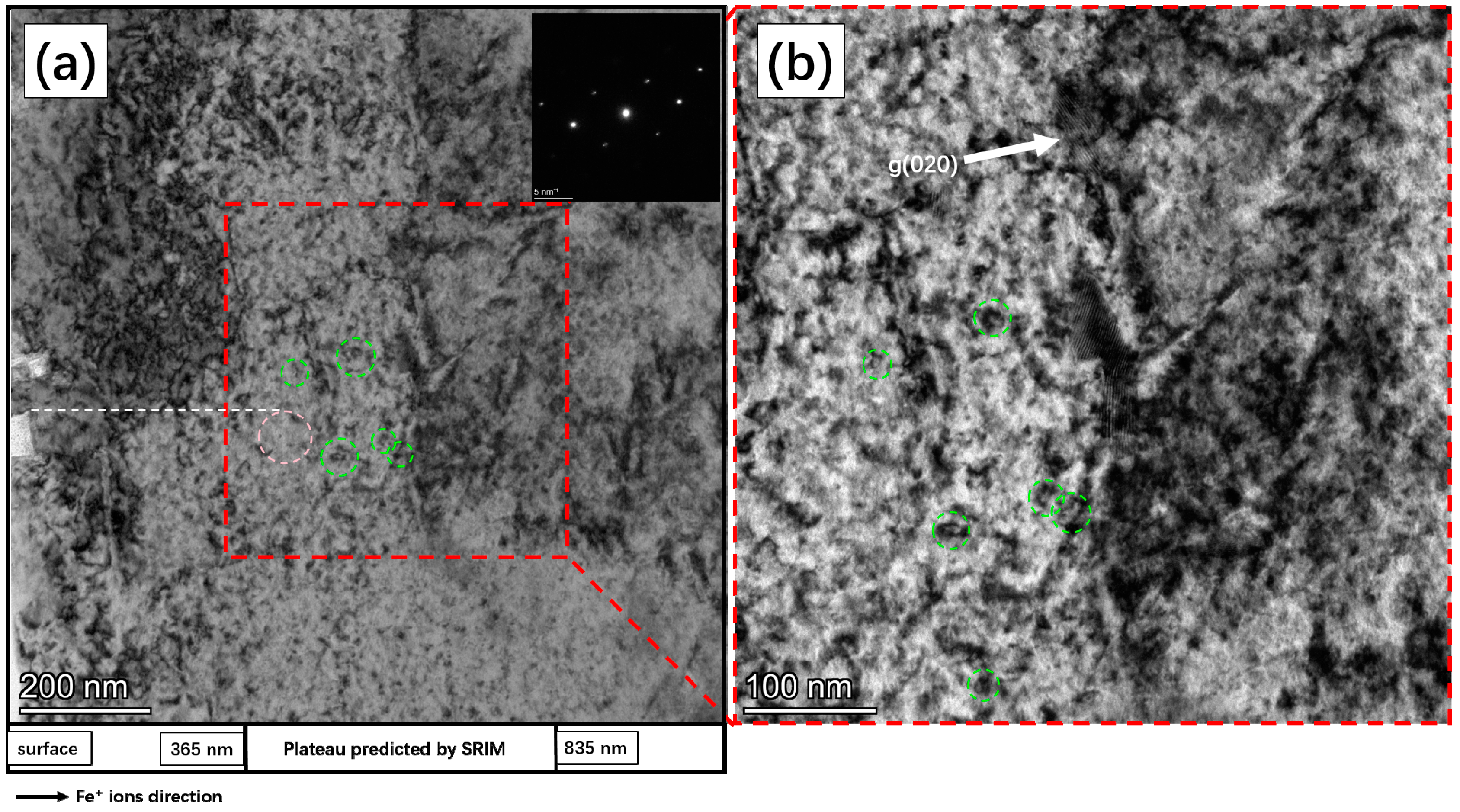
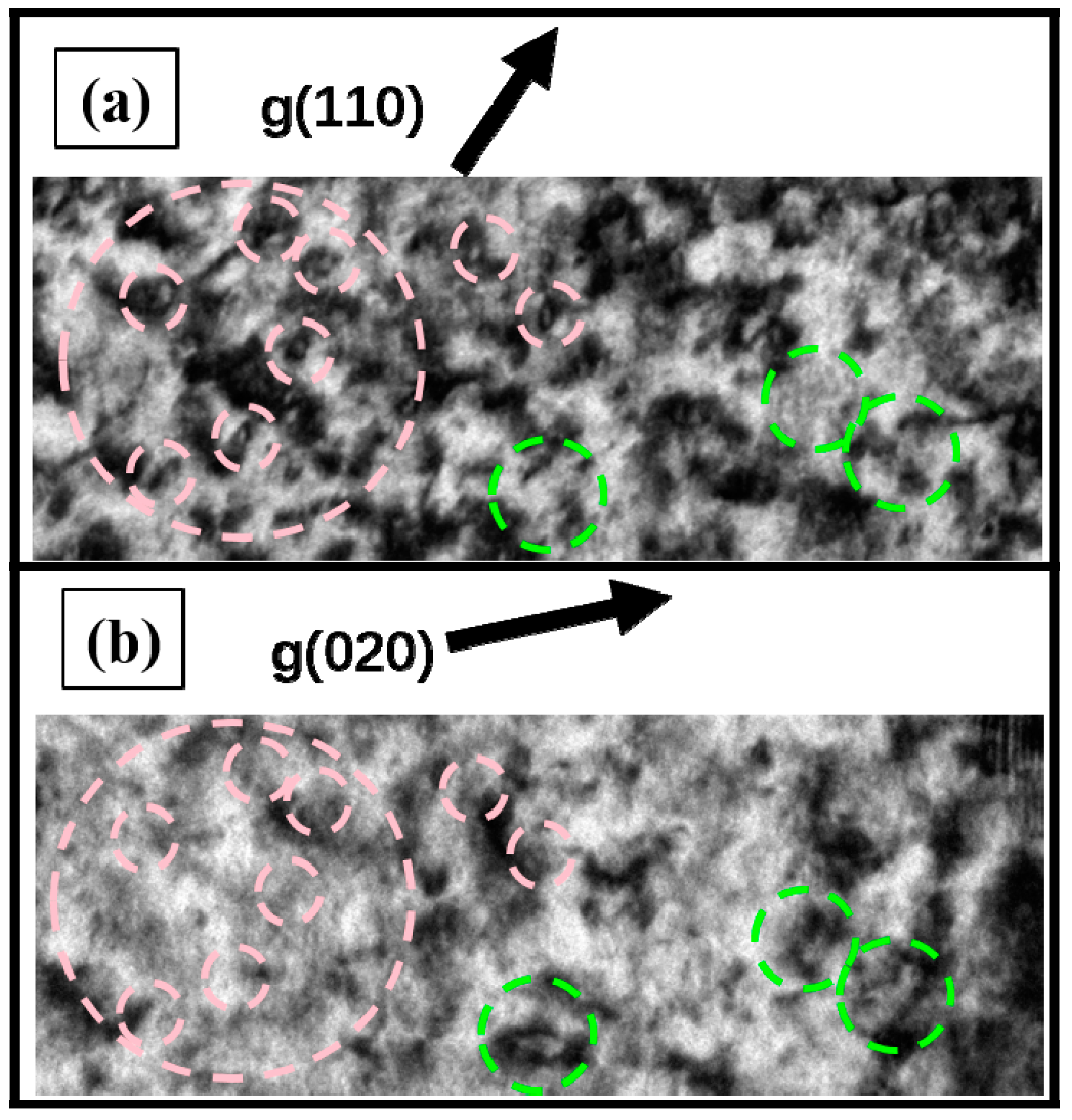

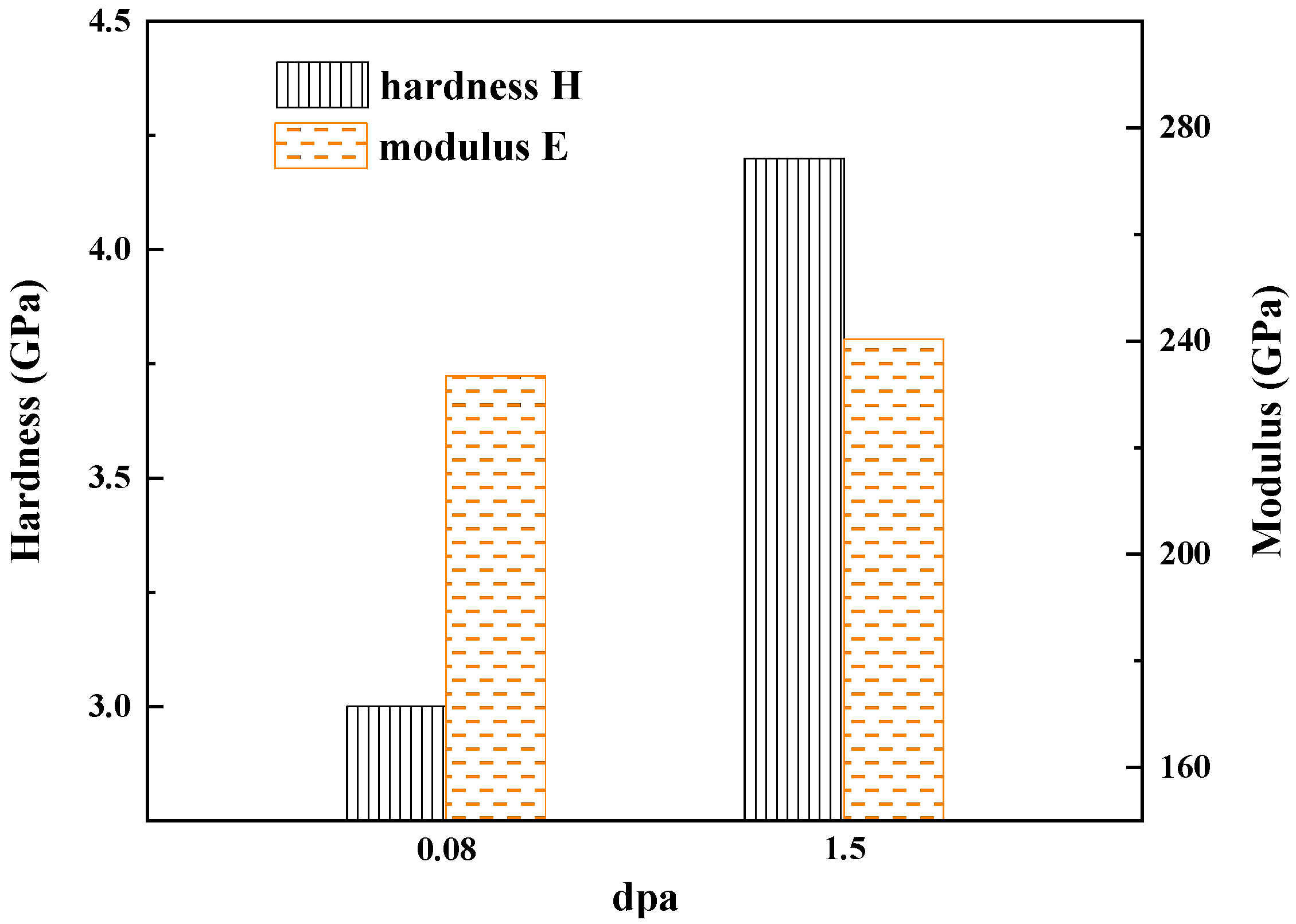
| Element | Fe | C | Si | Mn | S | P | Cr | Ni | Cu | Mo | V |
|---|---|---|---|---|---|---|---|---|---|---|---|
| wt. % | Bal. | 0.167 | 0.193 | 1.35 | 0.002 | 0.005 | 0.086 | 0.738 | 0.027 | 0.481 | 0.007 |
| Element | Atomic Fraction | Mass Fraction | Fit Error |
|---|---|---|---|
| % | % | % | |
| C | 3.57 | 0.76 | 7.39 |
| Si | 0.04 | 0.02 | 10.10 |
| P | 0.03 | 0.01 | 20.80 |
| S | 0.04 | 0.03 | 42.60 |
| V | 0.04 | 0.03 | 5.96 |
| Cr | 0.60 | 0.55 | 0.61 |
| Mn | 6.65 | 6.47 | 0.15 |
| Fe | 61.70 | 61.00 | 0.06 |
| Cu | 26.70 | 30.00 | 0.11 |
| Mo | 0.68 | 1.15 | 1.70 |
| 1 | 1 | 0 | 2 | 2 | 0 | 0 | |
| 0 | 2 | 0 | 2 | 2 | −2 | −2 | |
| 2 | 0 | 0 | 2 | 2 | 2 | 2 |
Publisher’s Note: MDPI stays neutral with regard to jurisdictional claims in published maps and institutional affiliations. |
© 2022 by the authors. Licensee MDPI, Basel, Switzerland. This article is an open access article distributed under the terms and conditions of the Creative Commons Attribution (CC BY) license (https://creativecommons.org/licenses/by/4.0/).
Share and Cite
Ma, X.; Zhang, Q.; Song, L.; Zhang, W.; She, M.; Zhu, F. Microstructure Evolution of Reactor Pressure Vessel A508-3 Steel under High-Dose Heavy Ion Irradiation. Crystals 2022, 12, 1091. https://doi.org/10.3390/cryst12081091
Ma X, Zhang Q, Song L, Zhang W, She M, Zhu F. Microstructure Evolution of Reactor Pressure Vessel A508-3 Steel under High-Dose Heavy Ion Irradiation. Crystals. 2022; 12(8):1091. https://doi.org/10.3390/cryst12081091
Chicago/Turabian StyleMa, Xianfeng, Qiang Zhang, Ligang Song, Wenqing Zhang, Meng She, and Fei Zhu. 2022. "Microstructure Evolution of Reactor Pressure Vessel A508-3 Steel under High-Dose Heavy Ion Irradiation" Crystals 12, no. 8: 1091. https://doi.org/10.3390/cryst12081091
APA StyleMa, X., Zhang, Q., Song, L., Zhang, W., She, M., & Zhu, F. (2022). Microstructure Evolution of Reactor Pressure Vessel A508-3 Steel under High-Dose Heavy Ion Irradiation. Crystals, 12(8), 1091. https://doi.org/10.3390/cryst12081091







